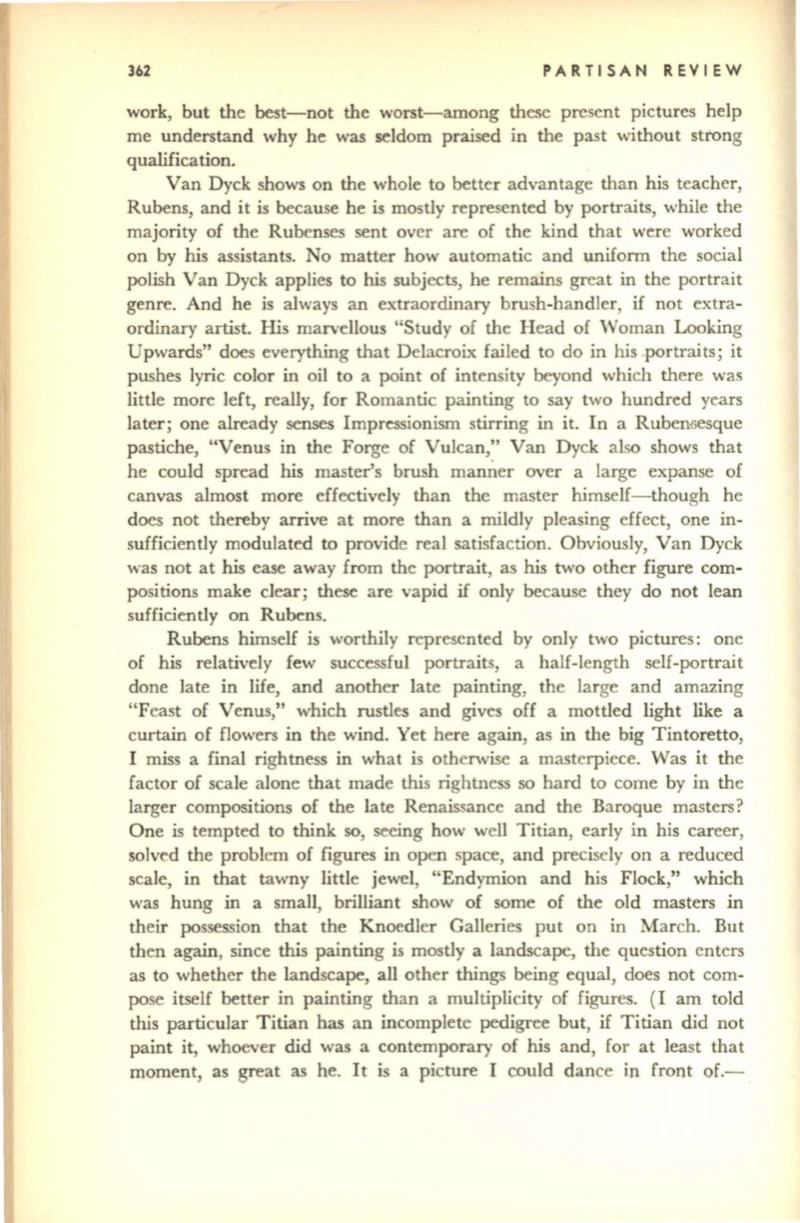
362
PARTISAN REVIEW
work, but the best-not the worst-among these present pictures help
me understand why he was seldom praised in the past without strong
qualification.
Van Dyck shows on the whole to better advantage than his teacher,
Rubens, and it is because he is mostly represented by portraits, while the
majority of the Rubenses sent over are of the kind that were worked
on by his assistants. No matter how automatic and uniform the social
polish Van Dyck applies to his subjects, he remains great in the portrait
genre. And he is always an extraordinary brush-handler, if not extra–
ordinary artist. His marvellous "Study of the Head of Woman Looking
Upwards" does everything that Delacroix failed to do in his portraits; it
pushes lyric color in oil to a point of intensity beyond which there was
little more left, really, for Romantic painting to say two hundred years
later; one already senses Impressionism stirring in it. In a Ruben6esque
pastiche, "Venus in the Forge of Vulcan," Van Dyck also shows that
he could spread his master's brush mamler over a large expanse of
canvas almost more effectively than the master himself-though he
does not thereby arrive at more than a mildly pleasing effect, one in–
sufficiently modulated to provide real satisfaction. Obviously, Van Dyck
was not at his ease away from the portrait, as his two other figure com–
positions make clear; these are vapid if only because they do not lean
sufficiently on Rubens.
Rubens himself is worthily represented by only two pictures: one
of his relatively few successful portraits, a half-length self-portrait
done late in life, and another late painting, the large and amazing
"Feast of Venus," which rustles and gives off a mottled light like a
curtain of flowers in the wind. Yet here again, as in the big Tintoretto,
I miss a final rightness in what is otherwise a masterpiece. Was it the
factor of scale alone that made this rightness so hard to come by in the
larger compositions of the late Renaissance and the Baroque masters?
One is tempted to think
so,
seeing how well Titian, early in his career,
solved the problem of figures in open space, and precisely on a reduced
scale, in that tawny little jewel, "Endymion and his Flock," which
was hung in a small, brilliant show of some of the old masters in
their possession that the Knoedler Galleries put on in March. But
then again, since this painting is mostly a landscape, the question enters
as to whether the landscape, all other things being equal, does not com–
pose itself better in painting than a multiplicity of figures. (I am told
this particular Titian has an incomplete pedigree but, if Titian did not
paint it, whoever did was a contemporary of his and, for at least that
moment, as great as he. It is a picture I could dance in front of.-


